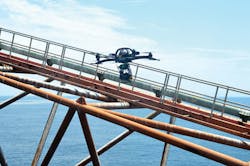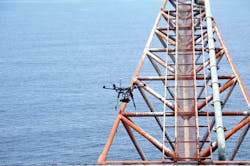Unmanned aircraft systems create new opportunities to gather essential data
Programs should augment existing operations while improving safety, efficiency
Todd Chase
Oceaneering
Unmanned aircraft systems have created many opportunities to improve safety and efficiency in the oil and gas industry. Applications range from infrastructure and maintenance inspection to security, emergency response, and environmental and regulatory compliance. Companies are exploring the best approaches, operationally and financially, to incorporate unmanned aerial system (UAS) programs into their business processes. UAS programs are most valuable when they augment existing operations while improving safety, and are supported by all necessary processes, procedures, and management systems.
Growing adoption
UAS programs are increasingly used to collect data safely. These programs will not replace manpower in situations where repairs or “hands-on” requirements exist, but they will certainly avoid the many limitations of current data collection approaches while also enhancing data sets.
Often, drones and other UAS solutions are used to refine and augment something that people were already doing, while eliminating the human footprint and associated risk exposure in dangerous areas. Infrastructure maintenance and monitoring applications include inspecting bridges, flare stacks, and the insides of tanks and boilers; assessing road deterioration; and detecting process changes. UAS programs can also be used for surveys and geographic information system (GIS) data gathering across tasks such as 3D modeling, topography studies, and watershed and mining analyses. Additional applications include wildlife monitoring, pipeline inspection and right-of-way analysis for environmental and regulatory compliance, as well as a variety of emergency response programs and security initiatives.
Planning a program
An organization’s aviation department should be notified when UAS operations are first considered. Numerous decisions must be addressed, chief among them being the choice of whether to subcontract services from a third-party provider or to build and deploy a solution internally. Important issues for consideration include data management needs, program size and scope, and cost and control trade-offs. In some applications, such as refining and offshore exploration, there may be elevated risks or other special requirements to consider.
Many companies have determined that it makes better economic sense to subcontract their UAS program to a third-party service provider rather than to invest in the necessary staff, equipment, and resources to develop a program themselves. To a certain extent, these organizations will be better positioned to keep up with dynamic industry developments. For other companies, though, there may be a critical need to maximize control over how data is collected, or to make a sound business case that supports staffing and equipping an in-house team. The challenge with the latter approach is to allocate adequate resources and attention to keeping the program up to date as technology and safety guidelines evolve. These organizations also will need to educate themselves regarding what to look for in both equipment and pilots for maximum safety, performance and environmental protection, and how to implement industry guidelines and best practices established by the International Oil & Gas Producers (IOGP) organization, the Helicopter Safety Advisory Conference (HSAC), and Oil & Gas UK, among others.
Choosing which UAS is the best fit for an application can be particularly challenging. There are a wide variety of unmanned aircraft on the market, with tremendous differences in their design and ability to safely execute missions. Not all of them are suited to the special demands of oil and gas applications that have extremely rigorous requirements for capturing and processing operational data. Every UAS in these applications should be “fit for purpose.” In some operations, even a single bucket that goes overboard is a reportable object requiring scrutiny by senior management and even regulatory bodies. For all organizations, the need for safety, alone, narrows the field of appropriate equipment choices. The reality is that there is no inherently safe unmanned aerial vehicle (UAV); redundancies in flight control and navigation systems are essential, and whatever equipment is chosen must not only serve its purpose but also operate at the highest levels of safety, efficiency, and reliability.
Clearly, UAS selection is extremely important. However, in the long term, a focus on people, training, equipment, procedures, and experience is far more important than the actual UAS purchase.
Training and equipment
Safety is paramount, and industry organizations, such as the HSAC, have played a key role in focusing attention on best practices in this area. HSAC has facilitated collaboration among major oil and gas companies that has resulted in today’s IOGP recommendations for safe UAS operation - a living document that is the first to provide high-level guidance for industrywide UAS recommended practices. The IOGP Aircraft Management Guidelines is the source document and basis for oil and gas aviation and, with the growing use of UAS programs, IOGP has also released a similar guide, Unmanned Aerial Systems Guidelines, to provide a framework of guidance and expectations for UAS operations.
In addition to following HSAC/IOGP guidance, UAS program operators are expected to have their own manuals and standard procedures for optimizing risk control and safety management. Many companies in the energy industry have created very detailed requirements for how their drones are incorporated into a wide range of processes. Key focus areas include job safety analyses, hazard identification and an overall risk assessment process, as well as work permitting.
All program procedures should be audited and should comply with the ISO 9001 Quality Management System. Program elements should include a safety management system, along with inspection and reporting procedures and the UAS operator should be FPAL-registered and CAA/FAA-approved. The organization should also have a well-defined health, safety and environment policy in place, observe best practices for facility and environment training, and invest in the adequate insurance coverage for all subcontracted work.
UAS pilot recruitment must also be carefully managed, from the initial curriculum vitae review and candidate interviews, through flight and psychometric tests and the final interview. Training is also critical, and starts with pre-study sessions and ground school before moving through basic, intermediate, and advanced flying training and on to camera operation courses. Mentor programs, currency training, and annual standards checks should also be established.
The hardware focus for UAS program equipment should be on proven reliability, using a bespoke aircraft and software system featuring multiple redundancies. All equipment should be operationally proven, capable of flying in high wind conditions, and should also be approved for helo freight and have little impact on simultaneous operations.
Training pilots to operate safely and effectively in the highly challenging offshore environment is an exacting and time-consuming process. Not all individuals will reach the standards required. The use of a structured, building-block approach coupled with real-world practical experience in less demanding areas has proved to be the most effective approach. Ultimately, the UAS operator should present a defined, competency-based program that incorporates systematic processes that allow the individual UAS pilot to build experience and seasoning toward offshore UAS operations. All phases of UAS training programs should emphasize the ability to precisely operate the aircraft in all modes and to execute emergency procedures effectively.
A similarly high level of experience is expected of all senior offshore inspectors, who also should have a global perspective and special expertise in oil and gas operations.
Deployment benefits
A UAS program provides numerous advantages over alternative data-gathering approaches, across a variety of applications. For instance, a UAS can be used to visualize a flare tip in a way that is significantly more safe and efficient than having a person climb up scaffolding. Plus, unlike humans, a UAS can be used to inspect a flare tip while it is operating, and this can be done at a cost that is generally lower than dispatching a helicopter. In these and other applications, UAS programs create new opportunities to gather essential data.
Fully realizing these benefits at the highest levels of safety and efficiency requires a laser focus on industry-best practices for operational excellence. The oil and gas industry has created this foundation, along with an environment in which UAS operations are now generally viewed in the same way as manned operations, with an emphasis on quality, safety, and risk management. Organizations that embrace these industry guidelines will also be able to maximize cost and efficiency as they use their UAS program to augment existing processes in ways that make the most economic sense.


